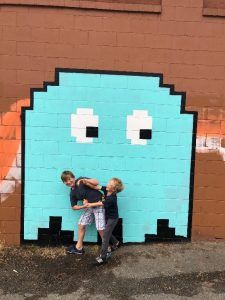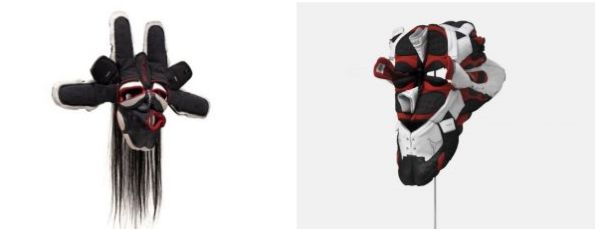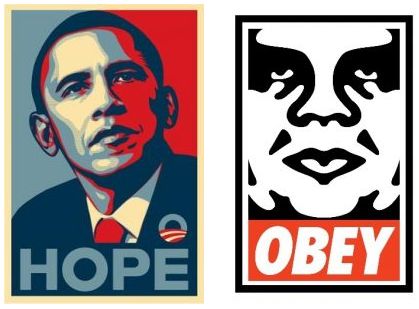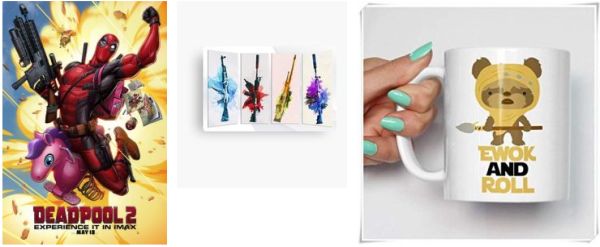This month, Vancouver hosted the Vancouver Mural Festival (VMF) which celebrates Vancouver's dynamic and growing arts and culture scene (dance, music, food, crafts) surrounded by the city's best and most stunning outdoor mural art.
More information on the VMF can be found on their site, www.VanMuralFest.ca .
As we wound our way through the festival streets, laneways and alleys, we couldn't help but notice some challenging and beautiful fan art on show. Some of it was featured in murals, while some of it was being sold. Is this appropriation or merely appreciation?
What is fan art?
Fan art is artwork created by fans of a works of fiction and derived from a series-character or other aspect of that work. This can range from amateur sketches to full blown murals or works of sculpture. There is a diversity of expression within this genre – a lot of it on display at the VMF.
Fan art creators on display at the VMF
Two young fans discuss the legality of a Pacman inspired mural by an unknown muralist at the VMF (please contact t.borycki@segev.ca to provide artist attribution credit).

Transformers inspired murals at VMF by AA Crew and DEDOS

Mario Brothers inspired art on show at VMF by Ben Duncan

© Ben Duncan, 2019. Used by permission.
Ben Duncan is a local artist clearly inspired by video game art who creates some compelling original pieces based on characters produced by Nintendo. Here, Ben Duncan repurposes the character 'Mario' from the popular 'Mario Brothers' franchise for his own anarchic artistic vision. You can check out more of Ben's great work on his site www.benduncanmadeit.com
Some other examples of fan art
Brian Jungen is an artist of Dane-Zaa and Swiss ancestry living and working in the North Okanagan of British Columbia. He has shown his art globally, including at New York's New Museum, the Vancouver Art Gallery and the Shanghai Biennale. Below, he uses Air Jordans to create bold masks that link globalization with perceptions of Indigenous cultures.

Jungen's work is a twist on conventional fan art. He takes his fandom of Air Jordan's to new heights – transforming the Nike brand and product into new forms where the underlying intellectual property (IP) is unrelated to its original form, and difficult to recognize in the resulting art work.
In these two iconic pieces, Shephard Fairey uses a photo (Barack Obama and Andre the Giant) then alters it to create an artistic and political message.

While all these artists appropriate underlying material, their expression and technique vary wildly. Here are some more examples showing the range of fan art expression online:


What is the law?
The question at hand: is fan art considered appropriation or appreciation? Potential legal landmines for fan art fall into two main categories: copyright and trademark. Here's what you need to know.
Copyright
To be eligible for copyright, a work needs to be an original work of fixed in a tangible medium of expression. This includes (but is certainly not limited to) literature, music, plays, pictures and architectural works. Copyright cannot be applied to concepts, facts, ideas, or other broad principles. In both Canada and the US, copyright goes into effect automatically, even if a work is not published. The length of copyright varies in each country, but in Canada it lasts 50 years past the death of the creator of the work.
If there is a copyright, the right to reproduce the work (or, the right to copy) is controlled by the holder of that copyright. This rights holder also controls the display and distribution of all derivative work. Since fan art is, by definition, derivative, the display and distribution of such work by anyone but the rights holder is considered to be unlawful.
Exceptions to the law
However, all hope is not lost, as there are certain exceptions. The most prominent is the fair dealing exemption, a notoriously vague doctrine. To qualify under the fair dealing exemption in Canada, the dealing must fit one of the enumerated purposes in the Copyright Act of Canada; research, private study, education, parody, satire, criticism or review and news reporting. Additionally, the dealing must be considered 'fair', a concept established and elaborated by the Supreme Court of Canada. Deciding what is considered 'fair dealing' is not an exact science — Canadian courts use a list of 6 non-exhaustive factors to guide them:
- Purpose of the dealing.
- Character of the dealing.
- Amount of the dealing.
- Alternatives to the dealing.
- Nature of the work.
- Effect of the dealing on the work.
Given that so much of fan art exists in the online world, another exception, known as the copyright 'mash-up' exception, is especially relevant to note. Section 29.21 of Canada's Copyright Act notes that an individual can "use an existing work...or copy of one...in the creation of a new work or other subject-matter in which copyright subsists." This provision was designed to allow for things such as a home video recording with music playing in the background. In the age of YouTube, it is relied upon constantly.
However, this provision requires that the new work be for "solely non-commercial purposes." Therefore, you can't use your creation as advertising or to sell something. You also need to cite the source if it is 'reasonable' to include the citation in your work. You also need to be 'reasonably sure' that the underlying work you use was not from an illegal copy of the original work. Finally, your mash-up must not affect the market for the original work negatively.
Trademark
The second legal landmine for fan art is trademark. Protection in the trademark realm covers the right to claim you are the rightful source of a good. Trademarks are violated when a 2nd party markets goods so that the public might believe they are buying from the rightful source. Trademarks can protect words or phrases, company logos, and can also extend to packaging.
In Canada, the Trademarks Act provides for the registration of trademarks and the enforcement of registered and unregistered rights. There are also rights conferred through common law, rights which are limited to the geographic area where the trademark has been used.
In the Canadian trademark realm, you could potentially be sued for the following: passing off or infringement, the latter which can include descriptions of goods that are materially false and mislead the public as to their character, geographic origin or mode of manufacture. You could also be sued for depreciation of goodwill (similar to the concept of trademark dilution in America), but only if the trademark has been registered.
If you are sued, the plaintiff bears the burden of proving their case on a balance of probabilities. In infringement and passing-off actions, a common defense is absence of likelihood of confusion.
Likelihood of confusion is determined by reference to the following (though it is not limited to these factors):
- The inherent distinctiveness of the trademarks or trade names and the extent to which they have become known;
- The length of time the trademarks or trade names have been in use;
- The nature of the goods, services or business;
- The nature of the trade;
- The degree of resemblance between the trademarks or trade names in appearance or sound or in the ideas suggested by them.
What does this mean for creators of fan art?
Despite the fact that most fan art is legal only through narrow exceptions, the medium continues to flourish. This is in large part because rights holders view fan art and the community that creates it as having a positive effect on their underlying intellectual property. The community that creates fan art is among the most loyal of a given TV program or character, and using legal means to dissuade this enthusiasm would, in most cases, be counterproductive. Allowing fans to create works of appreciation typically increases their feelings of loyalty and passion for a show and likely benefits the rights holders in the long run by bringing more fans to the show and/or having their fans purchase more affiliated products. It is, in a sense, free promotion.
Also, given that most fan art is produced on a small scale, the optics of a major rights holder suing or going after a fan would likely be undesirable. No rights holder wants to alienate their most passionate fans over a few dollars.
This does not mean rights holder will ignore their legal rights in all circumstances. For example, JK Rowling accepts and encourages fan art of her Harry Potter series made by genuine fans which is not sold and so long as the creator makes it clear that Rowling is unaffiliated. However, if it falls outside the bounds of propriety, she objects to its creation and promulgation. For example, those who create art using her intellectual property that is either racist or overly sexual will attract scrutiny and swift legal action.
In conclusion
To ensure you can create your fan art without legal repercussions, we suggest the following.
- Know the Rules: Fan art and fan fiction communities sometimes have guidelines and some authors have made public statements on the issue. Do some digging before creating and uploading.
- Clearly Unofficial:Have clear, unambiguous statements on your site that your work is just a fan creation. This might not help with a trademark or copyright dispute, but it shows good faith and encourages rightsholders to work with you.
- Non-Commercial: Try to be completely non-commercial with your fan art. This means no selling copies, no sponsorships, no advertisements. Non-commercial uses are far more likely to fall under fair use than commercial uses. Note that just because something is non-commercial doesn't mean it is legal, and just because something is commercial doesn't mean it is illegal. There are ways that you can sell your fan art and have it be legal, though these exceptions are both narrow and fuzzy. If you are commercial, stay small. Size will attract attention from rights holders, which could lead to legal consequences.
- Treat Domain Names with Care: Your domain can become a trademark issue if it causes others to believe that you might be an official site.
- Cooperate with Requests:If the creator or their representative makes a request of you, listen to it and comply. This is a practical strategy to head off a legal confrontation before it starts.
Finally, the more original your work is, the more protected you are. Be creative instead of derivative, that's where the fun is anyway.
August 30th, 2019
The content of this article is intended to provide a general guide to the subject matter. Specialist advice should be sought about your specific circumstances.

